Introduction
In the modern organizational landscape, the concept of talent management is subject to diverse interpretations and approaches. Some scholars think that it is an integral part of an organization’s HR policies, while others think that it constitutes a distinct field, encompassing certain HR functions. Beyond the conventional functions of attracting, developing, and retaining talented individuals, effective talent management is seen as an instrument that can be used to align employee development with organization’s mission and vision. Moreover, talent management can serve as a strategic imperative, not only supporting current business objectives but also facilitating growth and ensuring the long-term prosperity and sustainability of the organization (Bratianu, 2018, 2022; Spender, 2014).
However, the exclusive adoption of talent management focused solely on top performers within an organization, which raises concerns about potential negative organizational behaviors among other employees. To mitigate this, an inclusive approach to talent management is preferable, emphasizing the wellbeing of all employees.
Employee wellbeing is a critical aspect of organizational success, influencing productivity, engagement, and overall company performance (Bakker, 2015). In recent years, there has been a growing recognition of the importance of creating a workplace that fosters and supports the wellbeing of its employees. This article explores various dimensions of employee wellbeing and examines the impact of a comprehensive approach on organizational outcomes. The multifaceted nature of employee wellbeing is explored through positive indicators such as work engagement and negative indicators like burnout and boredom.
Prioritizing employee wellbeing is not just a moral imperative but a strategic business decision. Organizations that invest in creating a holistic and supportive work environment reap the benefits of increased productivity, reduced turnover, and a more positive organizational culture. By addressing physical, mental, emotional, social, and developmental aspects of wellbeing, companies can build a resilient and thriving workforce that contributes to long-term success. The importance of leadership behavior in influencing employees is emphasized, with a call to recognize employee wellbeing as a primary and independent outcome rather than a secondary consideration.
In the complex interplay of talent management, leadership, and employee wellbeing, a holistic and inclusive approach emerges as pivotal for fostering a thriving organizational ecosystem. In our opinion, organizations can achieve their goal of attracting and retaining talented employees by introducing procedures and practices through which to develop an efficient talent management and by ensuring employee wellbeing.
Literature Review
Talent management is considered by some authors as a component of the organization’s HR policies or as bringing complementary HR policies. Other authors consider talent management to be a totally different field from HR, even if it embraces and develops certain HR functions, such as attracting, recruiting, developing and retaining employees. Different approaches also exist regarding the personnel segment to which talent management is addressed. Some authors believe that talent management refers only to identifying key positions within the organization and providing the necessary personnel to fill them, while other authors consider that talent management addresses all employees in the organization, giving it the possibility to identify and develop talents within the organization, so that they have the right person, at the right time, in the right workplace. Talent management, in addition to the function of attracting, developing and retaining talented employees, must ensure that staff development is done in accordance with the mission and vision of the organization, to support the current business and to enable the business growth and the prosperity and sustainability of the organization (Spender, 2014). In organizations that adopt exclusive talent management (the one focused only on elites), employees with high potential are privileged within the organization in relation to other employees, which could cause the latter to adopt a negative organizational behaviour (Fedorova, Naumov, Kalinina, & Sedyakina, 2020). Therefore, we believe that for ensuring employee wellbeing within organizations, an inclusive style of talent management would be preferable.
The discourse on employee wellbeing intersects with various factors, as outlined by scholars such as Bakker (2015, p. 839) who identified job satisfaction, burnout, work engagement and positive/negative affect as predictors of employee wellbeing. This idea can also be found in the article published by Ilies, Pluut, & Aw (2015, p.850). van den Bosch et al (2019, p.248) consider the concept of employee wellbeing as having two types of indicators: the positive ones, respectively work performance and work engagement, and the negative ones, respectively burnout and boredom. Węziak-Białowolska, Białowolski & McNeely (2019, p.158) identify a direct positive link between employee wellbeing and job satisfaction, also mentioning the indirect influence exerted by job control, trust and recognition on employee wellbeing, through job satisfaction and work engagement. Also, there is a strong link coming from the knowledge management and knowledge dynamics (Bratianu, 2023; Bratianu & Bejinaru, 2023).
In the article published in 2018, Wieneke et al. identify the role of leadership style as having a decisive role in relation to employee wellbeing, employee engagement and satisfaction. Also related to leadership style, Sparr & Sonnentag (2008, p.218) demonstrate that perceiving correct feedback from supervisors contributes to increasing the level of wellbeing, manifested by decreasing job depression and the intention to leave the organization and increasing job satisfaction. According to Inceoglu, Thomas, Chu, Plans, & Gerbasi (2018), the existing body of research on leadership behavior and its impact on employees has primarily focused on performance outcomes, with employee wellbeing often treated as a secondary consideration. The authors highlight the need to shift the paradigm and recognize employee wellbeing, encompassing psychological and physical aspects, as a crucial and independent outcome (Inceoglua et al, 2018). McGuire & McLaren (2009) consider that employee wellbeing could generate higher levels of employee commitment, which, as we know, leads to reduced absenteeism, increased performance and a decrease in the intention to leave the organization.
Findings and Results
The research on employee wellbeing was conducted using the papers indexed both in Web of Science and in Scopus. For both databases, the export was made in the 29th of October 2023 using the query “employee well-being” (All Fields) OR “employee wellbeing” (All Fields) OR “employee well being” (All Fields) for Web of Science, and TITLE-ABS-KEY(“employee well-being”) OR TITLE-ABS-KEY(“employee wellbeing”) OR TITLE-ABS-KEY(“employee well being”) for Scopus. Using the before-mentioned queries, we identified 1.922 papers indexed in Web of Science and 3.173 works indexed in Scopus.
The first articles published on the researched topics were: Warr, P. (1990). Decision latitude, job demands, and employee well-being. Work and Stress, 4, pp. 285-294 (for the articles indexed in Web of Science) and Tomeski (1975). Building human factors into computer applications: The computer profession must overcome a ‘jackass fallacy’. Manage Datamatics, 4 (4), pp. 115-120 (for the articles indexed in Scopus).
We analysed the yearly evolution of the number of papers published for both databases. The chart below highlights this evolution over time, showing only the period when the number of papers published annually began to be significant. It can be noted that the number of published papers has been steadily increasing, which reflects the growing interest for this concept.
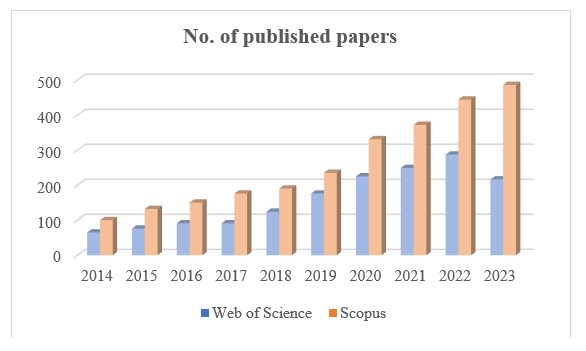
Fig. 1. Distribution by year of the papers having as subject employee wellbeing
Source: Authors’ own research
We also tried to identify the countries in which the highest number of papers were published. In the figure below, it can be noted that the countries with the greatest contribution to the development of the researched concept are practically the same, both as papers published in Web of Science and in Scopus.
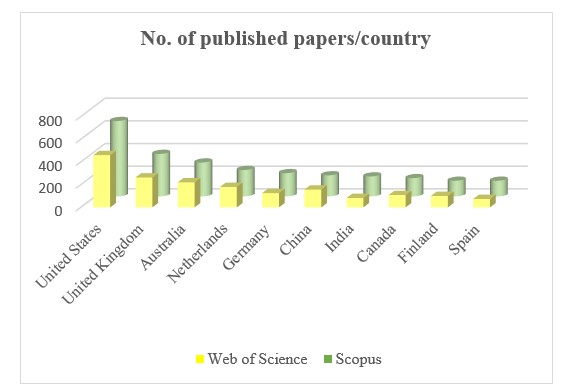
Fig. 2. Distribution by country of the papers having as subject employee wellbeing
Source: Authors’ own research
In our research, we tried to identify the authors with the largest number of papers approaching employee wellbeing, indexed both in Web of Science and Scopus. The results are presented in the following table.
Table 1. Number of works published by each of the authors
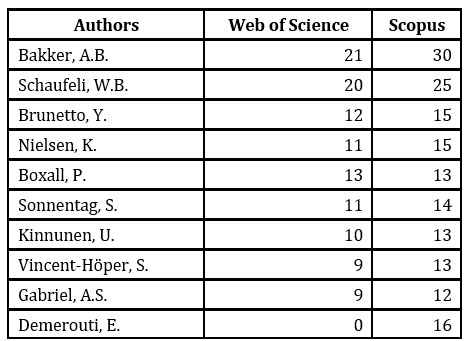
Source: Authors’ own research
The largest number of papers on the researched topic were published in the publications mentioned in the following tables. In the tables were mentioned also the number of citations and the journals found in both databases and were marked with the same colour.
Table 2. Journals which published the largest number of papers on the concept employee wellbeing
(Web of Science)
 Source: Authors’ own research
Source: Authors’ own research
Table 3. Journals which published the largest number of papers on the concept
employee wellbeing (Scopus)
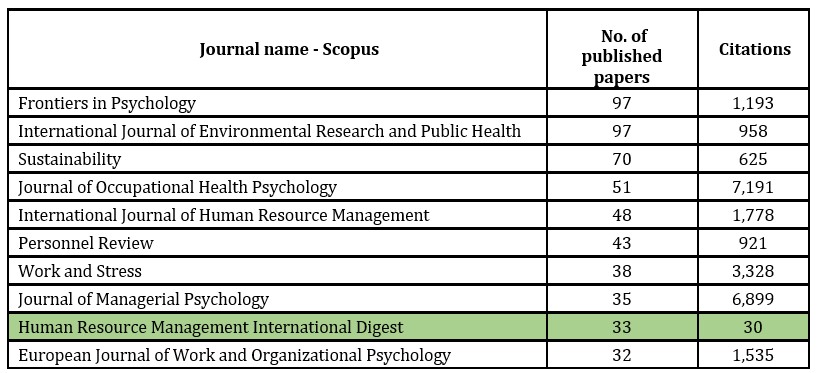
Source: Authors’ own research
The journals marked with a green background in the above tables can be found only in one of the two databases.
The most cited papers are presented in bellow tables, in which the papers found in both databases were marked with the same colour.
Table 4. Most cited papers on employee wellbeing (Web of Science)
Source: Authors’ own research
Table 5. Most cited papers on employee wellbeing (Scopus)
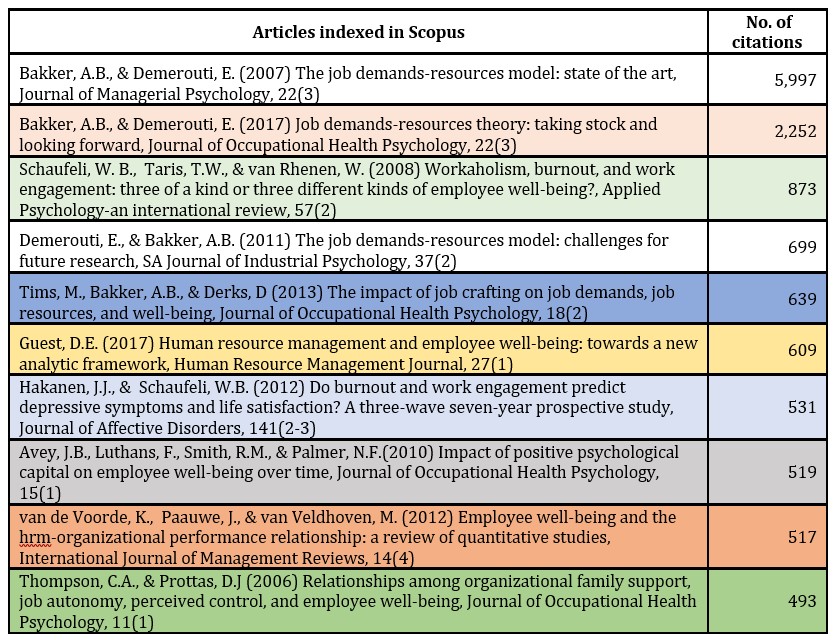 Source: Authors’ own research
Source: Authors’ own research
We performed a bibliometric analysis, conducted on papers indexed both in Web of Science and in Scopus, for employee wellbeing, using VOSviewer. The export was made using “Full Record and Cited References” for the papers indexed in Web of Science, and “Citation information”, Bibliographical information”, “Abstract & keywords” and “Include reference” from “Other information” for the papers indexed in Scopus. For both databases, “Co-occurrence” was used as “Type of analysis” and “Author keywords” as “Unit of analysis”. From the 6.162 keywords only 384 met the threshold 5 for the minimum number of occurrences of a keyword for the papers indexed in Scopus, and from 4.058 keywords only 253 met the threshold 5 for the minimum number of occurrences of a keyword for the papers indexed in Web of Science. It should be mentioned that, using the “Thesaurus” option, employee wellbeing was used to replace the keywords: employee well-being, employees’ well-being and employee well being.
The following network visualisations were obtained (we selected from the network visualizations only the area of interest for this research):
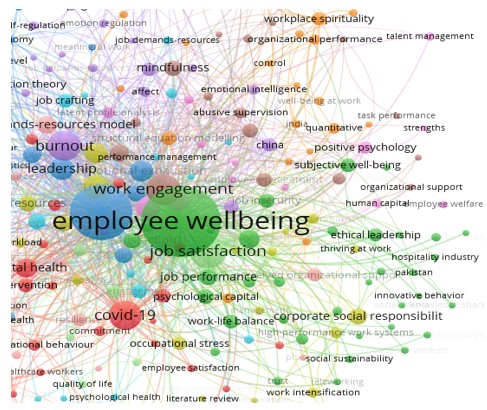
Fig. 3. The most widely used keywords related to employee wellbeing– by VOSviewer (Web of Science)
Source: Authors’ own research
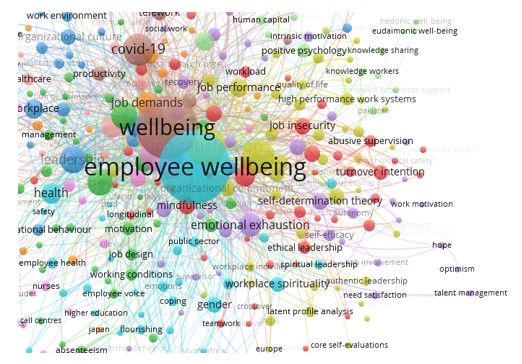
Fig. 4. The most widely used keywords related to employee wellbeing– by VOSviewer (Scopus)
Source: Authors’ own research
The most 20 powerful link strengths between employee wellbeing and related concepts were identified and we present them in the following tables (we excluded from the considered keywords: countries, research methods, theories):
Table 6. Keywords connected with employee wellbeing (Web of Science)
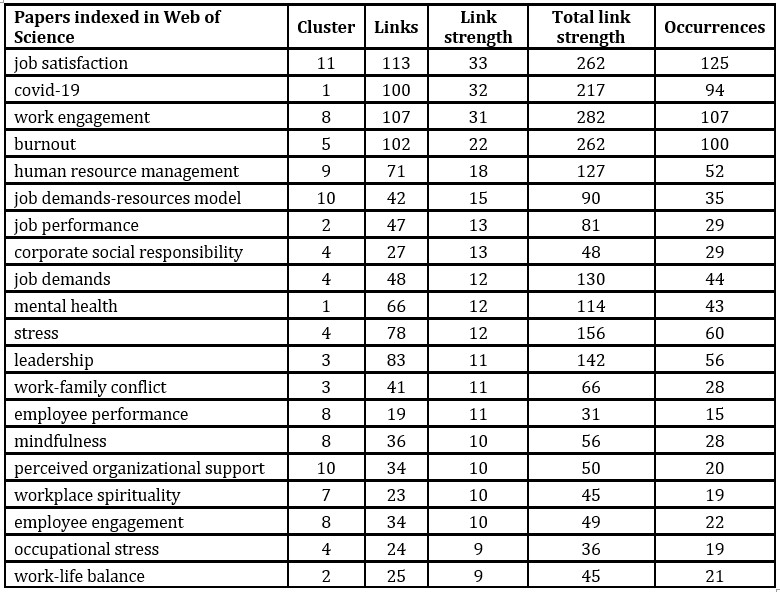
Source: Authors’ own research
Table 7. Keywords connected with employee wellbeing (Scopus)
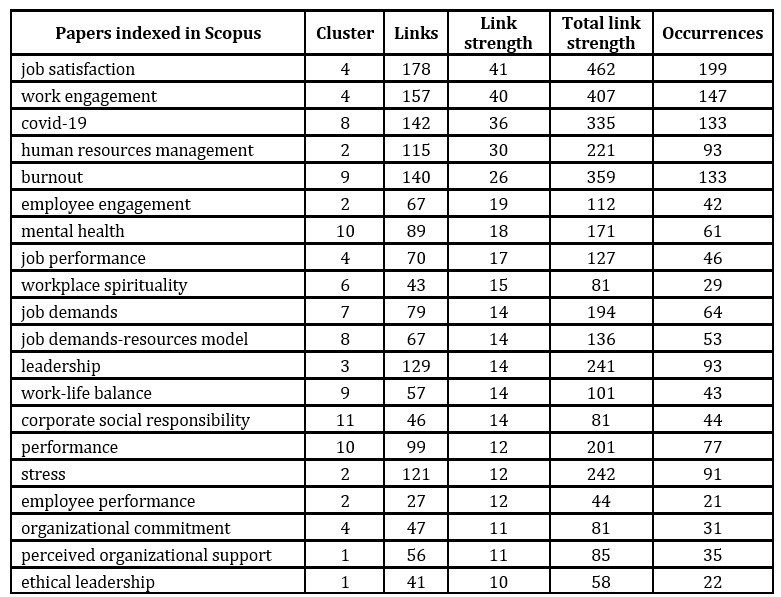 Source: Authors’ own research
Source: Authors’ own research
We analysed the clusters that present interest for our research, as they are organized by VOSviewer, clusters containing connected keywords. For the articles indexed in Web of Science, the cluster having as node employee wellbeing (cluster 2, green, containing 36 keywords) contains also the following related concepts: coping strategies, creativity, ethical leadership, innovation, innovative behaviour, intrinsic motivation, job burnout, job insecurity, job performance, knowledge sharing, knowledge workers, life satisfaction, organizational identification, perceived control, perceived supervisor support, person-job fit, psychological capital, psychological distress, psychological empowerment, psychological safety, psychological wellbeing, servant leadership, social capital, social media, social sustainability, subjective well-being, teleworking, trust, work environment, work-life balance and workplace friendship. Regarding the papers indexed in Scopus, the cluster having as node employee wellbeing (cluster 6, teal shade, containing 38 keywords) contains also the following related concepts: affect, coping, decent work, deep acting, emotion, emotion regulation, emotional labour, emotions, employee health, flourishing, happiness, health, health-oriented leadership, higher education, industry 4.0, innovative work behaviour, manufacturing, organizational citizenship behaviour, PTSD, safety, self-regulation, shift work, spiritual leadership, spirituality, supervisor support, surface acting, training, wellness, workplace intervention, workplace spirituality and workplace violence.
For the articles indexed in Web of Science, we found talent management in cluster 8 (node human resource management, lavender, 16 keywords) contains also the following related concepts: authentic leadership, employee welfare, hope, human capital, occupational well-being, organizational citizenship behaviour, performance, positive psychology, productivity, self-esteem, strengths, telecommuting and turnover. Regarding the papers indexed in Scopus, in the cluster having as node emotional exhaustion (cluster 5, lavender, containing 39 keywords) we found talent management together with the following related concepts: affective well-being, autonomy, basic psychological needs, competence, customer incivility, detachment, exhaustion, frontline employees, hope, hospitality, intrinsic motivation, job involvement, leader-member exchange, leadership behaviour, leadership style, meaningful work, need satisfaction, occupational well-being, optimism, person-job fit, proactive behaviour, psychological capital, psychological detachment, recovery, remote working, rumination, self-efficacy, social work, supervisor, transformational leadership, trust, vigour and work motivation. Talent management presents 7 links (work engagement, burnout, employee wellbeing, human resource management, performance, quantitative and stress) in the papers indexed in Web of Science, and 6 links (work engagement, burnout, employee wellbeing, human resource management, optimism and quantitative) in the papers indexed in Scopus.
We conducted also research on the other analysed concept, talent management, by using also papers indexed both in Web of Science and in Scopus. For both databases, the export was made in the 2nd of November 2023. We identified 2.459 papers indexed in Web of Science and 2.750 works indexed in Scopus. The export methods were the same as for employee wellbeing. We used “Thesaurus” and we replaced global talent management, strategic talent management, and human talent management by talent management, and we used the same type of analysis and counting method as for employee wellbeing. From the 4.913 keywords only 246 met the threshold 5 for the minimum number of occurrences of a keyword for the papers indexed in Scopus, and from the 4.683 keywords only 202 met the threshold 5 for the minimum number of occurrences of a keyword, and only 197 keywords were connected in the network for the papers indexed in Web of Science.
Using the above-mentioned analysis, the following network visualisations were obtained (we selected from the network visualizations only the area of interest for this research):
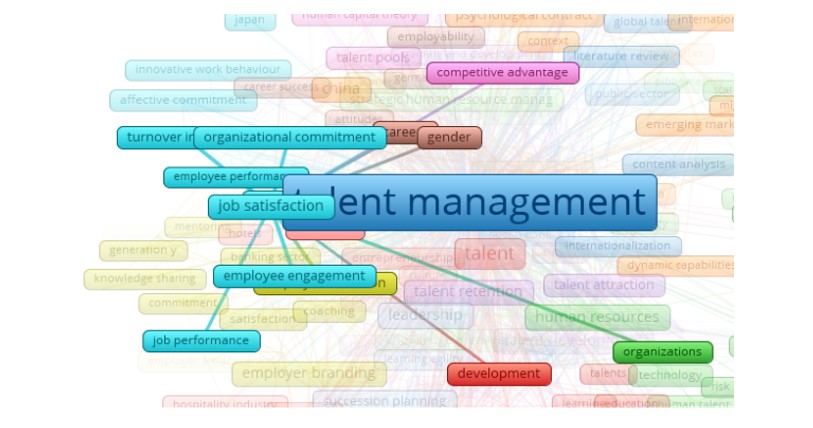
Fig. 5. The most widely used keywords related to talent management– by VOSviewer (Web of Science)
Source: Authors’ own research
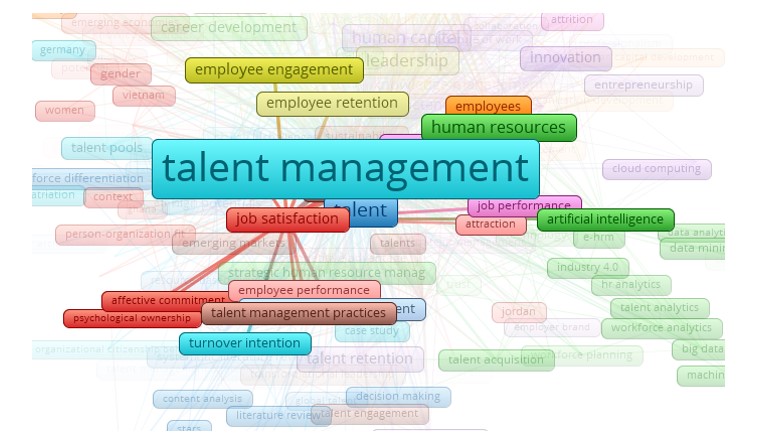
Fig. 6. The most widely used keywords related to talent management– by VOSviewer (Scopus)
Source: Authors’ own research
The most 20 powerful link strengths between talent management and related concepts were identified and we present them in the following tables (we excluded from the considered keywords: countries, research methods, theories):
Table 8. Keywords connected with talent management (Web of Science)
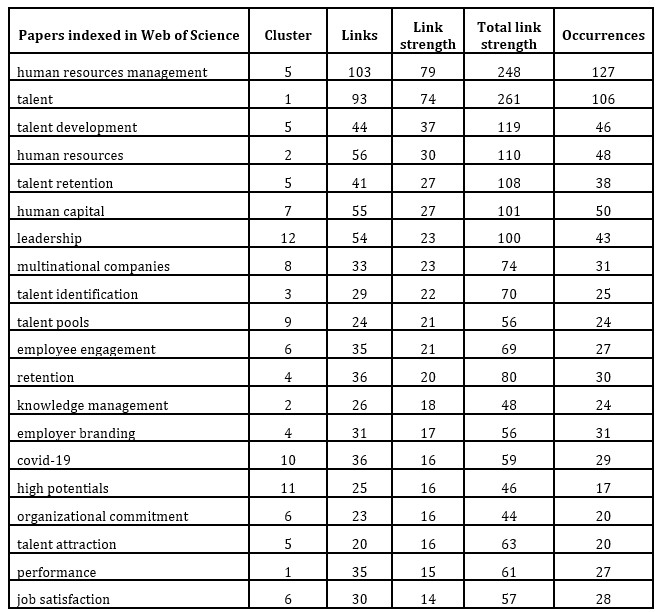 Source: Authors’ own research
Source: Authors’ own research
Table 9. Keywords connected with talent management (Scopus)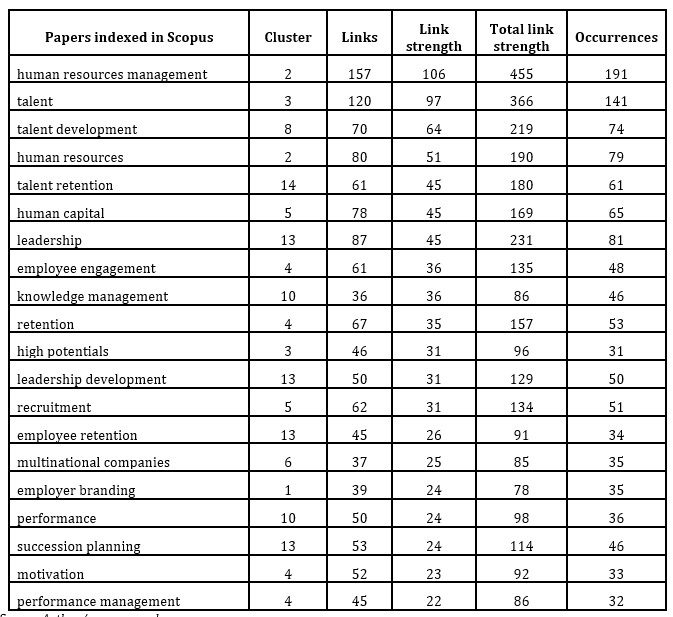
Source: Authors’ own research
We analysed the clusters that present interest for our research, as they are organized by VOSviewer, clusters containing connected keywords. For the articles indexed in Web of Science, the cluster having as node talent management (cluster 3, blue, containing 19 keywords) contains also the following related concepts: emerging economies, global talent, higher education, information technology, institutional logics, internationalization, knowledge transfer, public sector, SMEs, social capital, talent identification, talent management strategy, universities. Regarding the papers indexed in Scopus, the cluster having as node talent management (cluster 6, teal shade, containing 20 keywords) contains also the following related concepts: cross-cultural management, ethics, expatriation, global mobility, human capital theory, international HRM, multinational companies, organizational citizenship behaviour, organizational justice, talent pools, talent strategy, turnover intention and work engagement.
For the articles indexed in Web of Science, we found well-being in cluster 5 (node human resource management, lavender, 18 keywords) contains also the following related concepts: big data, career management, digital transformation, digitalization, HR practices, human resource development, human resources management, social networks, sustainability, talent acquisition, talent attraction, talent development, talent retention and training and development. Regarding the papers indexed in Scopus, in the cluster having as node human capital (cluster 5, lavender, containing 21 keywords) we found well-being together with the following related concepts: blockchain, cloud computing, collaboration, competences, competencies, competency development, corporate culture, diversity management, future of work, HR practices, human resource development, human resource strategies, innovation, knowledge, organizational change, organizational culture, recruitment, social capital and social media. Well-being presents 7 links (big data, employee development, HR practices, human capital, human resources management, sustainability, talent management) in the papers indexed in Web of Science, and 4 links (employees’ development, HR practices, human capital and talent management) in the papers indexed in Scopus.
Following the bibliometric analysis, we obtained the following link strength between the topics that were of interest for our research:
Table 10. Most powerful link strengths between related concepts and employee wellbeing/talent management
 Source: Authors’ own research
Source: Authors’ own research
To analyse link strength, we grouped topics on five criteria: job satisfaction, engagement, performance, leadership and human resources management.
In our analysis, we will sum up the results obtained for work engagement and employee engagement, because Kosaka, D. & Sato, H. (2020) demonstrate that they describe the same organizational behaviour.
Conclusions
Following the literature review, we expect to identify the following links between talent management and employee well-being: person-job fit, development opportunities, recognition and rewards, work-life balance, performance feedback and supports, career pathing and opportunities, work (employee) engagement, job satisfaction, leadership practices.
We will present our conclusions based on link strengths by presenting link strengths using the rule (link strength Web of Science/link strength Scopus)
The analysis demonstrated the existence of strong link strength between employee wellbeing and job satisfaction (33/41) and employee engagement (41/59), which was expected, given that these two organizational behaviours are components of employee wellbeing. A weak link strength was identified between talent management and job satisfaction (14/17), but a fairly strong one was identified with employee engagement (26/44). From this we can deduce that talent management influences employee wellbeing through the work (employee) engagement component.
Strong link strength was identified between both concepts and performance (82/74 with employee well-being and 74/74 with talent management), which was expected given that both employee wellbeing and talent management contribute to increasing performance within the organization.
The leadership style can lead to an increase or decrease in the level of employee wellbeing, and talent management contributes to the introduction within the organization of a leadership style that leads to employee wellbeing, so as to allow the organization to attract, develop, and choose to keep within it the most valuable employees. Under these conditions, the link strength registered by the employee wellbeing with the leadership components is 19/23, the latter registering a link strength of 27/49 with talent management.
On the other hand, a high level of job satisfaction and an increased level of employee commitment (determined by a high employee wellbeing) lead to decreased absenteeism and, especially, to a diminished intention to leave the organization. It should be mentioned that employee retention represents one of the main goals of talent management.
We believe that one reason that could lead to the low strength link identified between employee wellbeing and talent management is represented by the different formation of authors. While employee wellbeing is approached by authors working in psychology related to organizational behaviours, articles on talent management topic are written by authors who approach organizational behaviours from the perspective of management and consulting.
Another explanation is the employee wellbeing was analysed only in relation with human resources management and not in relation with talent management, which represents, in our opinion, a research gap and a direction for further research.
References
- Bakker, A.B. (2015) Towards a multilevel approach of employee well-being, European Journal of Work and Organizational Psychology, 24(6), 839-843
- Bratianu, C. (2018). A holistic approach to knowledge risk. Management Dynamics in the Knowledge Economy, 6(4), 593-607. https://doi.org/10.25019/MDKE/6.4.0
- Bratianu, C. (2022). Knowledge strategies. Cambridge, Cambridge University Press.
- Bratianu, C. (2023). Knowledge dynamics: Exploring its meanings and interpretations. Management Dynamics in the Knowledge Economy, 11(2), 100-111. https://doi.org/10.2478/mdke-2023-0007
- Bratianu, C. & Bejinaru, R. (2023). From knowledge to wisdom: Looking beyond the knowledge hierarchy. Knowledge, 3(2), 196-214. https://doi.org/10.3390/knowledge3020014
- Fedorova, E.S., Naumov, K.V, Kalinina, O.K, & , Sedyakina, A.A. (2020) The development of integrated approaches to talent management in the organization, IOP Conf. Ser.: Mater. Sci. Eng., 940
- Ilies, R., Pluut, H., & Aw, S.S.Y. (2015) Studying employee well-being: moving forward, European Journal of Work and Organizational Psychology, 24(6), 848-852
- Inceoglu, I., Thomas, G., Chu, C., Plans, D., & Gerbasi, A. (2018). Leadership behavior and employee well-being: An integrated review and a future research agenda, The Leadership Quarterly, 29(1), 179-202, https://doi.org/10.1016/j.leaqua.2017.12.006.
- Kosaka, D. & Sato, H. (2020) Employee Engagement and Work Engagement: Same Wine, Different Bottles?, Annals of Business Administrative Science, 19, 227–239
- McGuire, D., & McLaren. L. (2009) The impact of physical environment on employee commitment in call centres: the mediating role of employee well-being, Team Performance Management. 15(1/2), 35–48
- Sparr, J.L. & Sonnentag, S. (2008) Fairness perceptions of supervisor feedback, LMX, and employee well-being at work, Europen Journal of work and Organizational Psyhology, 17(2), 198-225.
- Spender, J.-C. (2014). Business strategy: Managing uncertainty, opportunity, & enterprise. Oxford, Oxford University Press.
- van den Bosch, R., Taris, T.W., Schaufeli, W.B., Maria C., W. Peeters, M.C.W. & Reijseger, G. (2019). Authenticity at Work: A Matter of Fit?. The Journal of Psychology, 153(2), 247-266.
- Węziak-Białowolska, D., Białowolski, P. & McNeely, E. (2019) Worker’s well-being. Evidence from the apparel industry in Mexico, Intelligent Buildings International, 11(3-4), 158-177
- Wieneke, K.C. et al. (2019). The Supervisor’s Perceived Role in Employee Well-Being: Results From Mayo Clinic. American Journal of Health Promotion, 33(2), 300-311



















